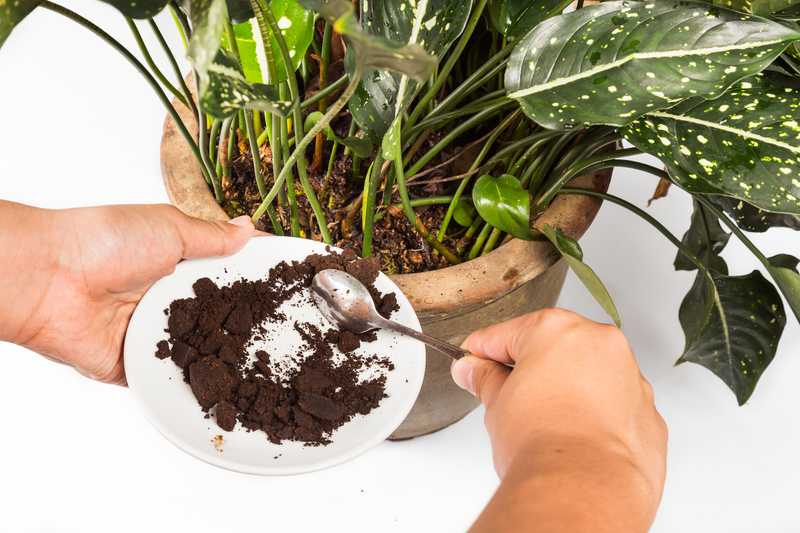Effective strategies for healthy orchid growth
Posted on 20/05/2025
Orchids are among the world's most fascinating and diverse flowering plants, cherished for their extraordinary beauty and variety. However, cultivating healthy orchids demands not only attention to detail but also a good understanding of their unique care requirements. Whether you are a novice or an experienced enthusiast, adopting proven techniques is crucial for ensuring robust orchid growth and abundant blooms. This comprehensive article explores effective strategies for healthy orchid growth, providing the knowledge and tips necessary to help your orchid collection thrive year-round.
Understanding Orchid Basics
The Diverse World of Orchids
With over 25,000 species and more than 100,000 hybrids, orchids (family Orchidaceae) are one of the largest plant families on Earth. They inhabit nearly every continent except Antarctica, adapting to environments ranging from tropical rainforests to alpine grasslands. Healthy orchid development often hinges on identifying your orchid type and catering to its specific needs.
- Phalaenopsis (Moth Orchids): Popular and suited for beginners. Thrive in moderate humidity and indirect sunlight.
- Dendrobium: Appreciate high humidity and cooler nights.
- Cattleya: Known for their large, fragrant blooms and preference for bright, filtered light.
- Vanda: Love bright light and excellent air circulation.
- Oncidium: Tolerate a range of conditions but perform best with good ventilation and regular feeding.
Knowing your orchid's genus is the first step in creating the optimal environment for healthy orchid growth and vigor.

Providing the Ideal Environment
Light Requirements for Orchids
Light is a critical factor in successful orchid growth. Most orchids thrive in bright, indirect sunlight, as direct rays can scorch their delicate leaves. To test if your orchid is getting sufficient light, observe leaf color:
- Bright Green: Indicates healthy light levels.
- Dark Green: Suggests insufficient light; move your plant closer to a light source.
- Yellowish or Red Tinge: May signal too much sun; filter light with a sheer curtain.
For indoor growers, east or south-facing windows are ideal. If natural light is insufficient, supplement with full-spectrum grow lights for consistent, year-round growth. Rotate pots regularly to promote even development and prevent leaning.
Temperature & Humidity Management
Correct temperature and humidity are vital components in orchestrating healthy orchid growth strategies. Most orchids prefer day temperatures between 65-80?F (18-27?C) and night temperatures of 55-65?F (13-18?C).
- Warm Growers (e.g., Phalaenopsis): Maintain consistent temperatures, avoiding cold drafts.
- Cool Growers (e.g., Cymbidium): Require cooler night temps to initiate blooming cycles.
Humidity levels should be maintained at 40-70%. Use a humidity tray, room humidifier, or group plants together to create a microclimate. Misting can also help, but avoid over-saturating leaves to reduce the risk of fungal diseases.
Air Circulation
Good air movement is essential in preventing problems like mold, mildew, and pests. Install a small oscillating fan near your orchids to simulate gentle tropical breezes and maintain fresh airflow. This is especially important in enclosed spaces where stagnant air can facilitate disease.
Watering Your Orchids Correctly
How Much and How Often?
Overwatering is a common cause of poor orchid health. Unlike many houseplants, most orchids are epiphytes, meaning their roots are designed to absorb water quickly and dry out between waterings. Follow these tips for optimum orchid watering strategies:
- Let roots dry: Wait until the potting medium is nearly dry before rewatering.
- Water thoroughly: Drench the pot until water runs freely out of drainage holes.
- Morning is best: So leaves and roots can dry before evening, reducing disease risks.
- Adapt to seasons: Orchids need less water in winter and more in active growing periods.
Tip: Use tepid, non-chlorinated water or rainwater for best results. Avoid letting water sit in the crown of the plant to prevent rot.
Choosing the Right Potting Medium
Orchid roots thrive in loose, airy media that promote rapid drainage and ample oxygen. Using the wrong substrate is a common mistake that restricts root health and active orchid growth.
- Bark Mix: Ideal for epiphytic orchids; retains moisture yet drains quickly.
- Sphagnum Moss: Excellent moisture retention; preferred for young plants.
- Coconut Husk Chips: Sustainable and slow to break down.
- Inorganic Mixes (Perlite, Charcoal, Clay Pellets): Improve aeration and prevent compaction.
Refresh or replace your orchid's potting mix every 1-2 years or when it becomes compacted or breaks down. This encourages strong, healthy roots essential for vigorous growth and bloom production.
Feeding and Fertilizing Orchids
The Importance of Balanced Nutrition
Orchids have modest nutritional needs but respond well to consistent, balanced fertilization. Using a quality orchid fertilizer can make a noticeable difference in orchid vitality, growth, and flowering.
- Use a balanced fertilizer: 20-20-20 or specifically formulated orchid blends are excellent choices.
- "Weakly, weekly" method: Dilute fertilizer to one-quarter strength and apply every week.
- Rinse monthly: Flush the potting media with plain water to prevent salt buildup, which can damage roots.
- Reduce in winter: When orchids are resting, cut back on feeding to prevent stress.
Note: Avoid generic houseplant food, as it may contain urea or improper ratios, potentially harming sensitive orchid roots.
Repotting for Healthy Roots
Signs Your Orchid Needs Repotting
Even with the best care, orchids eventually outgrow their containers or exhaust their potting media. Repotting is vital for maintaining orchid health and encouraging robust growth.
- Roots overflowing: Roots spilling over the pot indicate the need for a larger container.
- Decomposed medium: If the mix is compacted or has a sour odor, it should be replaced.
- Poor drainage: Water pools at the bottom, indicating clogged media.
- Pest or disease issues: Persistent problems may require a fresh start.
Spring, following the bloom period, is typically the best time to repot your orchid. Gently trim away dead or rotting roots and use a sterilized pot and tools to minimize infection risks.
Managing Orchid Pests and Diseases
Common Orchid Pests
Orchids are susceptible to several insect pests, including:
- Aphids - Sap-sucking and often found on buds and new shoots.
- Mealybugs & Scale insects - Cottony or brown bumps on leaves and stems.
- Spider mites - Fine webbing and stippled leaf surfaces.
Integrated Pest Management (IPM) is the key to sustained orchid health. Remove pests by hand, use insecticidal soaps, neem oil, or horticultural oil, and isolate infected plants to prevent spreading.
Recognizing and Preventing Diseases
Fungal and bacterial diseases thrive in damp conditions. Watch for:
- Leaf spots or rots
- Wilting or yellowing leaves
- Unpleasant odors
To prevent diseases, ensure:
- Proper air circulation
- Watering in the morning
- Quickly removing affected parts
- Sterilizing tools between uses
Encouraging Flowering and Reblooms
The Role of Light, Food, and Temperature
Getting your orchid to flower or rebloom is often the ultimate goal. Flowering is closely tied to overall health, so diligent care is needed:
- Increase light slightly after a resting period to stimulate buds.
- Feed with bloom-boosting fertilizer (higher phosphorus) before expected flowering season.
- Provide a slight night temperature drop for several weeks; this signals many orchids to initiate blooms.
Patience is key. Some orchids only bloom once a year, while others, like Phalaenopsis, can flower multiple times. Consistency in care leads to reliable, spectacular displays.
Best Practices for Long-Term Orchid Health
Creating a Routine and Observational Skills
Monitor your orchids regularly and respond to changes in their appearance or growth. A consistent routine helps catch potential issues early and allows you to adjust as necessary. Healthy orchid growth techniques center around:
- Checking roots and leaves weekly
- Adjusting care seasonally
- Improving growing conditions if issues arise
Keep an orchid journal to track watering, feeding, blooming cycles, and any problems encountered over time. This helps with troubleshooting and reveals patterns crucial to your learning process.

Frequently Asked Questions About Orchid Care
How often should I water my orchids?
Watering frequency depends on your orchid type, season, and growing conditions. Most orchids benefit from watering every 5-10 days. Always check the potting medium and allow it to nearly dry between waterings.
Why are my orchid's leaves turning yellow?
Yellow leaves can result from overwatering, poor drainage, or insufficient light. Assess root health, adjust watering habits, or provide brighter, indirect light to promote recovery.
When should orchids be repotted?
Orchids typically need repotting every 1-2 years, or if you notice decomposed potting media, excessive root growth, or pest infestations. Repot after blooming when the plant is less stressed.
How can I get my orchid to rebloom?
Provide a slight night-time temperature drop, increase light, and use a bloom booster fertilizer prior to expected flowering times. Avoid moving the plant once the flower spike appears, as stability encourages bud development.
Conclusion: Growing Vibrant, Healthy Orchids
Successfully nurturing healthy orchids is a dynamic blend of science, observation, and patience. By mastering the essentials--ideal lighting, correct watering, balanced feeding, appropriate potting media, and pest management--you can create a thriving orchid haven that rewards you with spectacular, enduring blooms.
Remember that each orchid is unique: take the time to learn its preferences, adapt to its natural rhythms, and apply proven orchid growth techniques. Through a commitment to these effective strategies for healthy orchid growth, you will enjoy not only the exotic beauty of your orchids but also the satisfaction of being a successful orchid caregiver for years to come.

